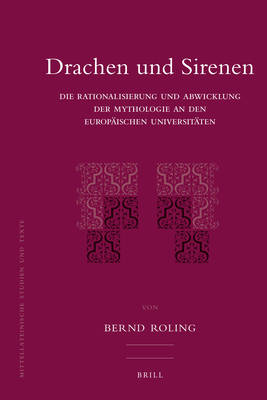
- Afhalen na 1 uur in een winkel met voorraad
- Gratis thuislevering in België vanaf € 30
- Ruim aanbod met 7 miljoen producten
- Afhalen na 1 uur in een winkel met voorraad
- Gratis thuislevering in België vanaf € 30
- Ruim aanbod met 7 miljoen producten
Zoeken
Drachen Und Sirenen
Die Rationalisierung Und Abwicklung Der Mythologie an Den Europäischen Universitäten
Bernd Roling
€ 482,45
+ 964 punten
Omschrijving
What kind of being did a sailor see, when he was confronted with a mermaid? A demon, a fairy, a monster, or only an extraordinary marine mammal? Transmitted by the tradition of ancient natural history the European universities faced many creatures belonging to natural science as well as to mythology, which still could be observed throughout the world. While medieval sholarship treated those beings as subjects for demonology, early modern scholars started to rationalize the sirens and satyrs and developed new models of explanation. Throughout hundreds of academical disputations the debate on hybrid creatures can be followed up to the time of Linné and Buffon and the zoological classifications of the 18th century.
This study reconstructs the discussions of hybrid creatures as part of the Early Modern change of paradigms and the longue durée of ancient and medieval natural history with the help of five examples, sirens, satyrs, giants, pygmies, and dragons.
This study reconstructs the discussions of hybrid creatures as part of the Early Modern change of paradigms and the longue durée of ancient and medieval natural history with the help of five examples, sirens, satyrs, giants, pygmies, and dragons.
Specificaties
Betrokkenen
- Auteur(s):
- Uitgeverij:
Inhoud
- Aantal bladzijden:
- 832
- Taal:
- Duits
- Reeks:
- Reeksnummer:
- nr. 42
Eigenschappen
- Productcode (EAN):
- 9789004185203
- Verschijningsdatum:
- 14/06/2010
- Uitvoering:
- Hardcover
- Formaat:
- Genaaid
- Afmetingen:
- 163 mm x 241 mm
- Gewicht:
- 1383 g

Alleen bij Standaard Boekhandel
+ 964 punten op je klantenkaart van Standaard Boekhandel
Beoordelingen
We publiceren alleen reviews die voldoen aan de voorwaarden voor reviews. Bekijk onze voorwaarden voor reviews.








